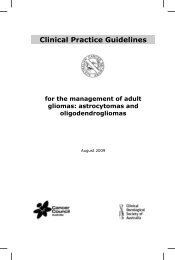Clinical Practice Guidelines for the management of locally advanced ...
Clinical Practice Guidelines for the management of locally advanced ...
Clinical Practice Guidelines for the management of locally advanced ...
You also want an ePaper? Increase the reach of your titles
YUMPU automatically turns print PDFs into web optimized ePapers that Google loves.
Recommendation<br />
3D con<strong>for</strong>mal dose escalated external beam radio<strong>the</strong>rapy alone, or reduced dose external<br />
beam radiation treatment in combination with high dose-rate brachy<strong>the</strong>rapy, are wellrecognised<br />
radical treatments <strong>for</strong> <strong>locally</strong> <strong>advanced</strong> disease. There is no randomised<br />
evidence to suggest superiority or to recommend one modality over <strong>the</strong> o<strong>the</strong>r.<br />
Grade D<br />
3.1.3 Radio<strong>the</strong>rapy and androgen deprivation <strong>the</strong>rapy<br />
For <strong>the</strong> purpose <strong>of</strong> this chapter we have considered <strong>the</strong> evidence in terms <strong>of</strong> short-term (six months or<br />
less) and long-term (more than six months) androgen blockade.<br />
Long term androgen deprivation<br />
Four randomised controlled trials 6, 31, 68, 89, 90 and two meta-analyses 32, 91 fulfilled <strong>the</strong> eligibility criteria<br />
<strong>for</strong> inclusion in this review. The control arm in <strong>the</strong>se trials was radio<strong>the</strong>rapy alone. Androgen<br />
deprivation consisted <strong>of</strong> oestrogen 90 , LHRH agonist 31,68, 89 ; and a non-steroidal anti-androgen. 6<br />
Duration <strong>of</strong> ADT ranged from two years to indefinitely and was commenced with radio<strong>the</strong>rapy 68 or at<br />
completion <strong>of</strong> radio<strong>the</strong>rapy. The radio<strong>the</strong>rapy dose to <strong>the</strong> prostate in three <strong>of</strong> <strong>the</strong> trials ranged from 65<br />
to 70 Gy. No data regarding radio<strong>the</strong>rapy were given in <strong>the</strong> fourth trial. 6 In two <strong>of</strong> <strong>the</strong> trials, pelvic<br />
lymph nodes were treated. 31, 68, 89 In all trials <strong>the</strong> endpoint <strong>of</strong> overall survival was examined.<br />
These studies showed a statistically significant improvement in overall survival with <strong>the</strong> exception <strong>of</strong><br />
<strong>the</strong> study by Zagars 90 , which was a low-quality study using long-term oestrogens. While improved<br />
31, 89, 90<br />
biochemical disease-free survival was also observed, it should be noted that in two <strong>of</strong> <strong>the</strong> trials<br />
indefinite ADT was recommended. Biochemical failure in <strong>the</strong> context <strong>of</strong> indefinite androgen<br />
deprivation most likely represents castrate-resistant disease and <strong>the</strong>se results should <strong>the</strong>re<strong>for</strong>e be<br />
interpreted with caution.<br />
Short-term androgen deprivation<br />
Only one RCT, Trans Tasman Radiation Oncology Group (TROG) 96-01, fulfilled <strong>the</strong> eligibility<br />
criteria <strong>for</strong> inclusion in this review. 28 This was a three-arm study comparing external beam<br />
radio<strong>the</strong>rapy (EBRT) alone versus three months <strong>of</strong> hormones plus EBRT (commenced two months<br />
prior to radio<strong>the</strong>rapy) versus six months <strong>of</strong> hormones plus EBRT (commenced five months prior to<br />
radio<strong>the</strong>rapy). ADT consisted <strong>of</strong> an LHRH agonist (goserelin) and a non-steroidal anti-androgen<br />
(flutamide). The radio<strong>the</strong>rapy dose was 66Gy in 33 fractions, which is lower than <strong>the</strong> current standard<br />
dose used in Australia (typically 74Gy). Subgroup analysis <strong>of</strong> patients with T3–4 disease and patients<br />
with PSA>20 was only available <strong>for</strong> <strong>the</strong> comparison <strong>of</strong> EBRT alone versus six months <strong>of</strong> hormones<br />
plus EBRT, with disease-free survival and prostate-cancer-specific survival reported. This<br />
demonstrated a statistically significant improvement in disease-free survival with <strong>the</strong> addition <strong>of</strong> six<br />
months <strong>of</strong> hormones, but not in prostate-cancer-specific survival.<br />
It should be noted that radiation doses were lower than current standard doses used in Australia and<br />
target volumes varied, with several trials treating pelvic lymph nodes. There are no RCTs addressing<br />
<strong>the</strong> use <strong>of</strong> ADT in conjunction with brachy<strong>the</strong>rapy and it remains unclear as to whe<strong>the</strong>r ADT provides<br />
a benefit in <strong>the</strong> era <strong>of</strong> higher-dose radio<strong>the</strong>rapy. On a final note, <strong>the</strong> Radiation Therapy Oncology<br />
Group (RTOG) 86–10 92 was not considered in this review as it did not meet inclusion criteria <strong>for</strong><br />
survival outcomes.<br />
<strong>Clinical</strong> practice guidelines <strong>for</strong> <strong>the</strong> <strong>management</strong> <strong>of</strong> <strong>locally</strong> <strong>advanced</strong> and metastatic prostate cancer<br />
30



